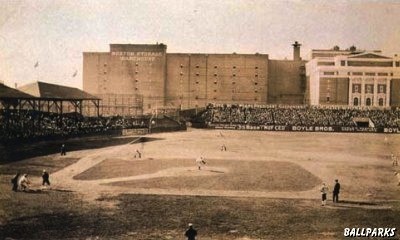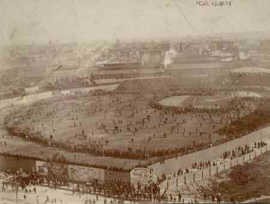Huntington Avenue American League Base Ball Grounds
Introduction
Text-to-speech Audio
Images
Overview of the main field (Boston Public Library)

View of the field full of spectators - rope was the greatest barrier to spectators, so eager fans would sometimes close in on the field in a ring, as shown here. (Boston Public Library)

Backstory and Context
Text-to-speech Audio
The Huntington Avenue Grounds were built in 1901, and reportedly constructed on what was previously an old circus lot. This resulted in a few oddities on the field that have persisted in memory perhaps for their quaintness, but didn't make for an ideal playing space. There were several places on the Grounds where grass would not grow, resulting in several sandy patches that punctuated the grassy field. An old tool shed remained from the field’s past life as a circus in the outermost part of the grounds, which was actually in play, posing a unique obstacle when hits would bounce around or against it.1
The Grounds were also unique in its physical dimensions, being substantially larger in parts of its lifetime than modern baseball fields, although the measurements for the field were periodically redrawn.2 With a very open design (barriers were made of rope, which were sometimes ignored entirely by fans who wanted to spectate more actively), the Grounds could accommodate a large number of people, but usually only saw about 5,000 at a time. 3
Despite the quirks of the field and what would now be considered an unconventional layout of the field, the Huntington Avenue Grounds have the distinction of hosting the very first modern World Series game in 1903, and witnessed the first perfect game, played by Cy Young, in 1904.4 Unfortunately, these claims to fame were not enough to keep the Grounds open forever – in 1912, barely a decade after its inauguration, the Huntington Avenue Grounds were closed, to eventually be replaced with Northeastern University’s indoor athletic Cabot Center. 5
